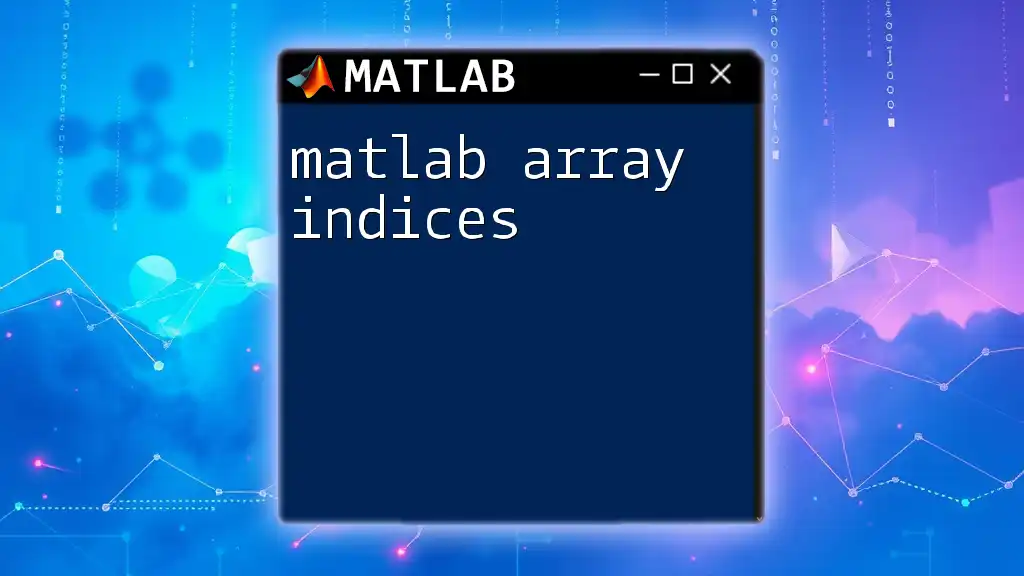The `arg` function in MATLAB retrieves the arguments of a function call, allowing users to identify and manipulate function input values effectively.
function myFunction(a, b)
disp(['The first argument is: ', num2str(a)]);
disp(['The second argument is: ', num2str(b)]);
end
Understanding Complex Numbers in MATLAB
What are Complex Numbers?
Complex numbers are fundamental in both engineering and scientific disciplines. These numbers take the form \(a + bi\), where \(a\) (the real part) and \(b\) (the imaginary part) are real numbers, and \(i\) represents the imaginary unit, which satisfies \(i^2 = -1\). In MATLAB, complex numbers are first-class citizens, and you can easily define them with the imaginary unit `i` or `j`.
Example: Consider the number \(3 + 4i\):
z = 3 + 4i;
Importance: Complex numbers are particularly utilized in electrical engineering, fluid dynamics, and control theory, where they simplify the representation of oscillatory systems.
Complex Number Representation in MATLAB
MATLAB represents complex numbers natively, allowing seamless operations between them. You can create complex numbers using the `complex` function, which enables you to define complex numbers directly from their real and imaginary parts.
Example:
z = complex(3, 4); % Equivalent to 3 + 4i

An Introduction to the `arg` Function
What is the `arg` Function?
The `arg` function in MATLAB is used to compute the angle, or phase, of a complex number. This function is crucial when working with phasors in signal processing or understanding oscillations, as it provides insight into the direction of the number in the complex plane.
Syntax of the `arg` Function
The basic syntax for using the `arg` function is:
theta = angle(z)
Here, `z` is the complex number, and `theta` is the output angle measured in radians.

Using the `arg` Function in MATLAB
Basic Usage
To calculate the argument of a simple complex number, you can use the following code:
z = 2 + 3i;
theta = angle(z);
disp(theta);
In this example, the argument of \(2 + 3i\) is computed and displayed. The output will be approximately \(0.983\) radians, representing the angle of the number from the positive real axis.
Working with Vectors of Complex Numbers
MATLAB excels in handling arrays of complex numbers. You can easily compute the arguments for entire vectors, which is efficient and straightforward.
Example:
z = [1+1i, 2+2i, 3+4i];
angles = angle(z);
disp(angles);
This code calculates the arguments for each complex number in the array and outputs them. The result will be a vector of angles corresponding to each complex number.

Visualizing the Argument with Plots
The Argand Diagram
An Argand diagram is a graphical representation of complex numbers in a two-dimensional plane, where the horizontal axis represents the real part and the vertical axis represents the imaginary part. Understanding this visualization helps in intuitively grasping the concept of complex numbers and their arguments.
MATLAB Code for Argand Diagram
You can create an Argand diagram using MATLAB’s plotting functions. Here’s an example that plots complex numbers and their angles:
z = [1+1i, 2+2i, 3+4i];
figure;
plot(real(z), imag(z), 'o');
hold on;
for k=1:length(z)
theta = angle(z(k));
% Draw line to origin
line([0 real(z(k))], [0 imag(z(k))], 'color', 'r');
end
axis equal;
xlabel('Real Part');
ylabel('Imaginary Part');
title('Argand Diagram');
grid on;
This code first plots the complex numbers and then draws lines from the origin to each point, visually representing their angles in the complex plane.

Advanced Applications of the `arg` Function
Using `arg` with Polar Coordinates
The `arg` function is intimately related to polar coordinates, where the complex number can be represented as \(r(\cos(\theta) + i \sin(\theta))\). The argument defines the angle \(\theta\), while the magnitude \(r\) is calculated using the `abs` function.
Example: Converting a complex number to polar coordinates can be done as follows:
z = 1 + 1i;
r = abs(z);
theta = angle(z);
disp(['Radius: ', num2str(r), ', Angle: ', num2str(theta)]);
This snippet calculates and displays both the radius and the angle of the complex number, enhancing your understanding of its geometric representation.
Combining `arg` with Other Functions
The `arg` function can be effectively combined with other MATLAB functions for advanced analysis. For example, understanding the relationships between the arguments of sums and products of complex numbers is crucial in fields such as phasor analysis.
Example:
z1 = 1 + 1i;
z2 = 1 - 1i;
theta1 = angle(z1);
theta2 = angle(z2);
theta_product = angle(z1 * z2);
disp(['Arg(z1): ', num2str(theta1), ', Arg(z2): ', num2str(theta2), ', Arg(z1*z2): ', num2str(theta_product)]);
This demonstrates that while the angle of the product of two complex numbers is the sum of their angles, the angle of their sum does not follow the same principle.

Common Mistakes and Troubleshooting
Misinterpreting the Output of the Arg Function
One of the common errors when using the `arg` function is misinterpreting its output. The results are given in radians, and many users might assume they are in degrees. Always verify the unit of measure and convert if necessary using:
degrees = rad2deg(theta);
Ensuring Correct Input Types
Another frequent pitfall lies in the confusion between real and complex numbers. Ensure that your inputs to the `arg` function are indeed complex. You can check this by using the `isreal` function before applying `arg`.
By following these guidelines, you can avoid common mistakes and ensure accurate results when using MATLAB to work with complex numbers.

Conclusion
Understanding the `arg` function in MATLAB enriches your ability to analyze and manipulate complex numbers efficiently. Whether you're working in engineering, physics, or applied mathematics, mastering this function can help simplify complex tasks. Keep experimenting with various examples and applications to solidify your grasp of complex numbers and their arguments.

Additional Resources
For further reading, you can visit the official MATLAB documentation, which provides detailed information on complex numbers and the `arg` function. Engaging with hands-on exercises that involve manipulating complex numbers in MATLAB will help reinforce your learning and enhance your programming skill set.

















